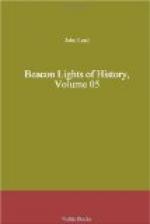Thus arose the University of Paris at the close of the twelfth century, or about the beginning of the thirteenth, soon followed in different parts of Europe by other universities, the most distinguished of which were those of Oxford, Bologna, Padua, and Salamanca. But that of Paris took the lead, this city being the intellectual centre of Europe even at that early day. Thither flocked young men from Germany, England, and Italy, as well as from all parts of France, to the number of twenty-five or thirty thousand. These students were a motley crowd: some of them were half-starved youth, with tattered clothes, living in garrets and unhealthy cells; others again were rich and noble,—but all were eager for knowledge. They came to Paris as pilgrims flocked to Jerusalem, being drawn by the fame of the lecturers. The old sleepy schools of the convents were deserted, for who would go to Fulda or York or Citeaux, when such men as Abelard, Albert, and Victor were dazzling enthusiastic youth by their brilliant disputations? These young men also seem to have been noisy, turbulent, and dissipated for the most part, “filling the streets with their brawls and the taverns with the fumes of liquor. There was no such thing as discipline among them. They yelled and shouted and brandished daggers, fought the townspeople, and were free with their knocks and blows.” They were not all youth; many of them were men in middle life, with wives and children. At that time no one finished his education at twenty-one; some remained scholars until the age of thirty-five.
Some of these students came to study medicine, others law, but more theology and philosophy. The headquarters of theology was the Sorbonne, opened in 1253,—a college founded by Robert Sorbon, chaplain of the king, whose aim was to bring together the students and professors, heretofore scattered throughout the city. The students of this college, which formed a part of the university, under the rule of the chancellor of Notre Dame, it would seem were more orderly and studious than the other students. They arose at five, assisted at Mass at six, studied till ten,—the dinner hour; from dinner till five they studied or attended lectures; then went to supper,—the principal meal; after which they discussed problems till nine or ten, when they went to bed. The students were divided into hospites and socii, the latter of whom carried on the administration. The lectures were given in a large hall, in the middle of which was the chair of the master or doctor, while immediately below him sat his assistant, the bachelor, who was going through his training for a professorship. The chair of theology was the most coveted honor of the university, and was reached only by a long course of study and searching examinations, to which no one could aspire but the most learned and gifted of the doctors. The students sat around on benches, or on the straw. There were no writing-desks.




